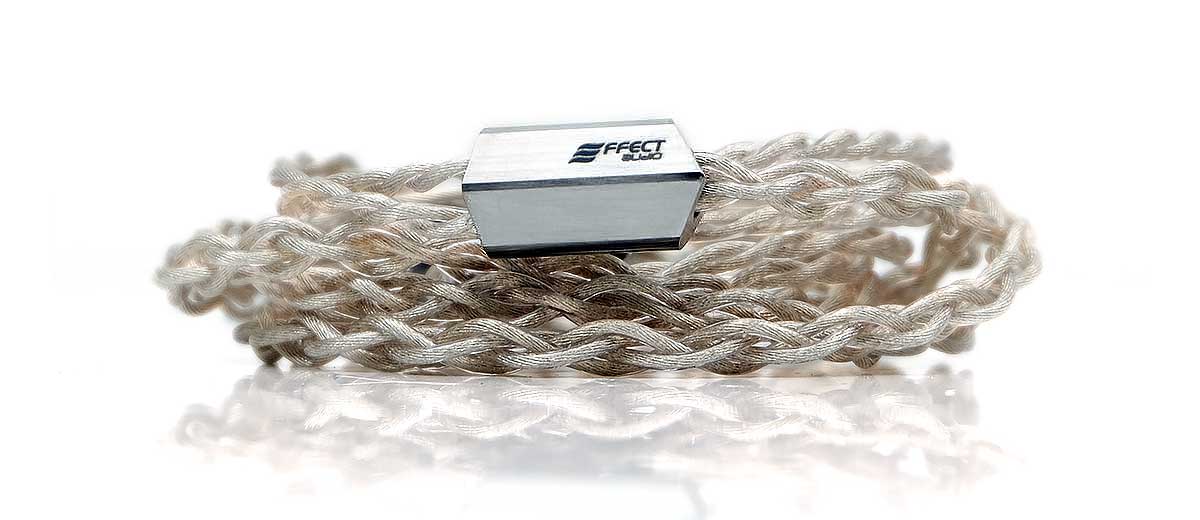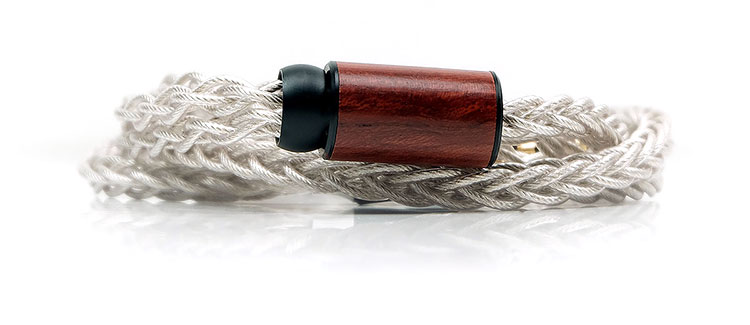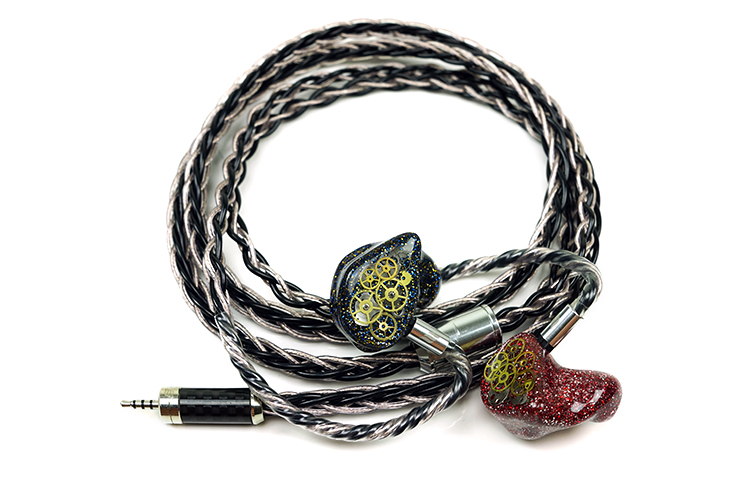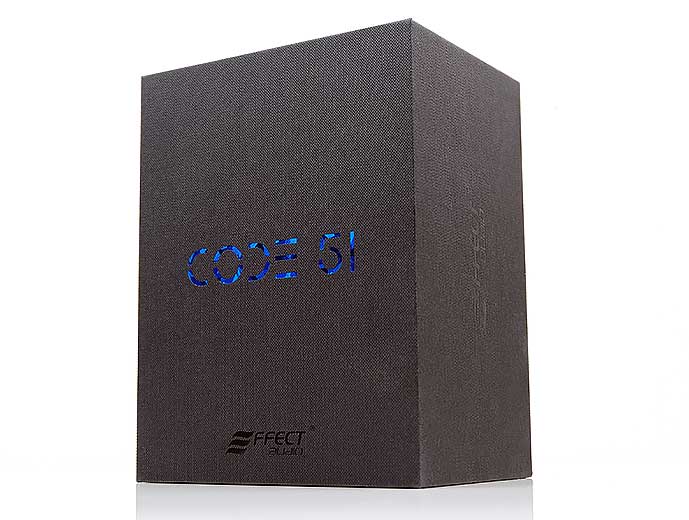Performance Impressions
Summary
For those concerned that a 4-wire will not perform as well as an 8-wire despite the increased size to 24AWG then think again. Code 51 is every bit as open and volume sensitive as the Leonidas II Octa.
Honestly, I could not find any significant volume adjustment between the two when tested with 64 Audio’s tia Trio, the VE Elysium, and JH Audio’s Layla. The dynamic range is also just as good, perhaps perceptibly better given its performance properties which we will get into.
In Summary, Code 51 is an ‘explosive’ sounding and highly resolving cable with the right pairings. Particularly so with monitors that have strong dynamic driver response or weightier BA subwoofer configurations. Monitors such as 64 Audio’s tia Trio, Noble’s Khan and the JH Audio Layla really lap up the additional weight and extension Code 51 delivers to their sub-end performance.
At the same time, that does not mean a sludge fest of body and warmth without definition. The Leonidas II Octa has some excellent low-end definition, but you could argue that the likes of the cheaper Cleopatra hits a bit harder or has more quantity.
Combine those two and you have Code 51’s low-end in a nutshell. It is crazy good how much additional rumble it can tease out of those aforementioned pairings. That’s fun, but fun with top-notch technical capability.
Timbre
This is a more complex timbre than the Leonidas II Octa. You get a lot more bass/treble contrast which helps with that explosive term I used in the summary. You also get a cleaner midrange that is influenced by a heightened treble presence that extends a bit more than the Leonidas II Octa.
As a result, it is not quite as warm as the Octa, not quite as organic in its overtones. Yes, at the same time this is not a neutral sound in the same manner as the TriSilver X8 from PLUSSOUND.
The lower harmonic order of most monitors when paired with Code 51 just seem to push a bit further forward so any note that strikes up to 1k sounds very solid, clean and pure. You could argue that it will deliver an intenser level of PRaT and “drive”, especially with dynamic driver hybrids.
This is quite the contrast to the Octa II timbre which delivers warmth and body but sounds softer on the edges. The tone is a little more laid back but still very complex in its layering. Code 51 retains that level of complexity in the layering but sounds tighter and more aggressive.
Staging
Code 51 delivers a deeper and taller staging experience with our paired monitors compared to some of the leading competitors such as Leonidas II Octa and PLUSSOUND’s Tri-Silver X8. The extension goes really low with some outstanding sub-bass response. This is the cable to tease out that bass texture and definition. There is nothing smeared with this cable to get that weighty sound.
The level of instrumental separation up into the mids on our tested monitors was perceptibly greater with Code 51. I suspect due to the slightly cleaner mids and that excellent depth stretching out the stage.
Now the treble is not quite as dry or peppy as the Tri-Silver X8. I still rate the X8 as the most treble centric of the leading cables out there. However, it does introduce a slight edginess into the harmonic balance of any monitor that is upper-mid-forward.
Code 51 retains the same level of airiness and separation but keeps the treble a little wetter and more natural to my ear. Any forward tuning on monitors in terms of upper-mid staging like percussion timbre is just a shade more refined as a result.
Synergy
64 Audio tia Trio
If you are coming from stock cables on the tia Trio and the Layla, OMG. That’s all I can say really because the frustrating veil on the Layla/stock cable pairing is entirely lifted from the mids using Code 51. The treble has more extension and air also which is just how I like the Layla. The tia Trio shows some similar lifts in dynamic range, especially on the low-end which sounds powerful and weighty.
JH Audio Layla
Now the Layla has some great bass for a balanced armature monitor but I tend to find it somewhat sludgy with the stock cable, especially when you up the bass level on its module. Code 51 cleans that up perfectly. I still would not have the bass module at full-blast on the Layla but with Code 51 the separation is much more convincing.
I tended to always use the Thor II or the Tri-Silver X8 with the Layla because of the excellent dynamic range and in the case of the X8 some excellent treble. Code 51 does all of that plus throw in that excellent Octa separation, more forward mids and a bit more sparkle up top. Famous last words but I cannot see how the Layla can sound any better with this pairing, to be honest with you.
Vision Ears Elysium
The Elysium comes with a really good stock cable so I can see less of an immediate need to upgrade compared to the Layla stock cable.
That being said the Elysium low-end gets a welcome lift sub-100Hz with a bit more rumble from its balanced armature driver. Mids have a bit more perceived ‘complexity’ with a really nice black background and a cleaner upper-mids/treble performance using Code 51. The stock cable has a touch more warmth on the Elysium vocal performance and not as much clarity in the upper bass and lower-mids.
Overall, Code 51’s weightier rumble and better separation will deliver a more convincing dynamic range and better engagement for me with the Elysium compared to the stock cable.
Select Comparisons
All comparisons were completed using a Lotoo PAW Gold Touch and 64 Audio’s tia Trio.
Effect Audio Leonidas II Octa
$1888
Technical
The Octa is our 2019 award-winning 8-wire 26AWG cable and with good reason. It packs an excellent palladium-plated silver & Litz silver hybrid mix of wires using a similar golden ratio principle and a proprietary Litz geometry.
Code 51 goes one step further with its gold-plated silver, silver-golds alloy, and palladium-plated silver. The Octa is a smaller wire compared to the 24AWG but it packs in 8 as opposed to 4 on the Code 51. That means slightly different handling properties for each cable.
The Octa design is very different with liberal use of a very attractive patina-style leather splitter combined with their in-house rhodium-plated PSquared jacks in multiple TRS, TRSS and balanced options. The connectors and splitters are not titanium on the Octa so they are not as tough and durable but they are lighter.
Memory retention is a little lower on the Octa and the braiding is also a bit tighter given the smaller wire. However, the microphonics on Code 51 below that titanium splitter are crazy good. Comfort levels favor Code 51 with that smaller diameter though there is no real weight advantage with those heavier Code 51 titanium splitter.
Performance
It is hard to think of a cable that can outperform the Leonidas Ii Octa but in a way, Code 51 does that. However, superior as it might be on the technical side it also brings a different tone to our test sample, the 64 Audio tia Trio. The differences may mean some people might still yearn for the Octa synergy despite Code 51’s technical superiority.
That is purely a personal preference thing but the difference is fairly clear if you have been referencing the Octa for a long time. Code 51 is clean, more explosive on the low-end and a shade taller to boot with more sparkle. It retains all the hallmarks of Octa’s holographic sound but adds even more depth and height to the tia Trio’s staging capability.
The Octa feels a shade more mid-centric by comparison despite its excellent holographic quality. There is a little less sub-bass quantity and a little more treble fade in the tia Trio presentation.
By contrast, the timbral performance of the tia Trio sounds a shade richer, more euphoric, and smoother on the Octa. Code 51/tia Trio midrange timbre has more of bass/treble contrast and slightly less warmth. Vocals do sound a little more forward when pairing the Trio with Code 51 and that cleaner midrange sound does improve perceived instrumental separation.
Overall, I get a sense of urgency, dynamic explosiveness and clarity with Code 51. Whereas with Octa, I get the same holographic staging on the tia Trio but a somewhat richer, smoother and more laid back tone.
PLUSSOUND Tri-Silver X8
$1600
Technical
The X8 we reviewed at the start of 2019 and I rank it in my top 3 cables for 2019. This is also a 26AWG 8-wire similar to the Octa with a palladium infused wire in its geometry. The mix of wire, however, is subtly different from the bigger 24WG Code 51.
The Tri-Silver uses a 26AWG Litz Type 6 geometry with 3 types of blended silver; pure silver, gold-plated silver, and palladium-plated silver. Code 51 uses gold-plated silver, silver-golds alloy, and palladium-plated silver. The key difference here is really that 24AWG sizing of wire that EA are using. The use of pure silver on the X8 means they do shape the performance of IEMs differently also.
Build wise you can tell the materials are close because both have that pale gold shimmer under their PVC jackets. I have to hand it to PLUSSOUND, their connectors are the best in the market for finishing. The titanium splitter on Code 51 does have better damping properties than the light wood of the Tri-silver X8. However, I love the X8 2-pin connectors for their rock-solid feel and smooth 2-pin sizing.
Having said that the jack and connector barrels are bigger and heavier on the X8 and the girth of the cable is much bigger so it is not quite as comfortable on the ear as Code 51.
Performance
Quite a few differences between these two flagship cables. The first is the general bass bias of the tia Trio when paired with both. Using the Tri-Silver X8, the bass has a bit of bloom but it was nowhere as extended or as powerful sounding compared to the Code 51 pairing. Using Code 51, the tia Trio PRaT and power was immediately obvious and made the Tri-Silver sound quite neutral sub 100Hz.
The second is separation, particularly in the mids of the tia Trio. Code 51’s vocal and instrumental separation was clearer for me than the Tri Silver X8’s presentation. The enhanced depth on the tia Trio is a factor in this providing a more spacious soundstage and enhancing that perception of separation on the Trio.
The final difference for me is the treble timbre. The Tri Silver X8 teases out a bit more treble forwardness on the tia Trio compared to the smoother Code 51 top-end. Percussion has a bit more presence on the Tri-Silver but sounds a shade drier compared to the Code 51. Also, the timbre on lead notes has a bit more of an edge on the X8 compared to the wetter hit of the Code 51 sound.
Effect Audio Janus (Dynamic)
$1399
Technical
The Janus was reviewed late 2018 and also picked up the cable award for 2018 from us. This was the first palladium-plated cable from Effect Audio and wowed me then and still does today.
The wire materials though are quite different from Code 51 beyond the use of palladium plating. The first is that split of materials into 4 wires apiece for the materials, (8-wire). The Janus uses palladium-plated copper for the first 4 wires and an in-house mix of gold-plated copper and a gold-alloy for the second set of 4 wires. This is in contrast to Code 51’s use of more expensive mixes of gold-plated silver, silver-golds alloy, and palladium-plated silver.
They do share one thing though and that is the use of 24AWG wiring. That does mean a similar longer throw braiding technique but for some reason, the thicker 24AWG Janus 8-wire holds its shape when unfurled much better. It never seems to retain any kinks. Perhaps that is a characteristic more of 24AWG 4-wire builds.
Build
I also love the noir aesthetic of the Janus two-tone black and silver finish. The light silver splitter is the perfect complement to the jacket finish of the Janus Dynamic. Code 51 has a more organic pale gold-tone so it looks very different from the Janus. The microphonics on Code 51 are spectacular. The Janus is good but not as good as Code 51 in that regard.
The final comparison is size. Yeah, the Janus is one heck of a big cable and bigger than Code 51 for sure. Code 51 is the comfier cable and not just because it is smaller. The Janus uses memory wire which makes it fairly wieldy around the ear with a lot more competitive pressure. Code 51’s memory wire is springier and softer and you hardly notice it at all on your ear.
Performance
The influence of the copper blend is more prevalent in many ways with the Janus Dynamic compared with Code 51. The flagship Code 51 is simply more explosive sounding whereas the Janus is richer, smoother throughout the curve with the tia Trio. Not that the Janus is bass shy but rather it creates plenty of body just not the same rumble and weight as Code 51’s superb low-end delivery with the tia Trio.
What I do like is the additional warmth the Janus delivers on the mids. It is superbly organic sounding, rich and smooth, especially in the upper mids and lower treble. With the Janus, the tia Trio pulls you into the mids more than anywhere really and delivers an almost euphonic experience.
Code 51 is cleaner for me with slightly better separation and a shorter decay in the upper mids. You will be more aware of nuanced detail compared to the Janus. Percussion timbre is a little on the more neutral side and can tease out a bit more treble sparkle. I still rate Code 51 as a smooth sounding tuning with the tia Trio but not as laid back as the Janus.
Our Verdict
Code 51 is an exciting, explosive and frankly outstanding cable. And, I cannot afford it, not even in my wildest dreams. That does not stop me from doffing my cap to the ingenuity Effect Audio has in delivering something that tops the ‘untoppable’, Leonidas II Octa.
And yet, I still have room for the Octa, it will retain its solid hardcore following with its more analog, warmish overtone. This is just so different. Code 51 is a blast of energy from top to bottom and will make practically any worthwhile monitor sound the same. Particularly dynamic drive hybrids that need a mix of power and separation. Or a balanced armature mix where a subwoofer tuning is more dominant like the JH Audio Layla.
Dropping from 8 to 4-wire should have no concerns for anyone here who can afford this beast. It is comfortable, quiet and handles really nicely. I am going to superglue this onto the Layla or tia Trio I think. Pretty sure this cable is not coming off in the near future except for cleaning connectors. Where to go from here?
Effect Audio Code 51 Specifications
- 24AWG
- Selected Premium UP-OCC Material
- Gold Plated Silver / Silver Gold Alloy / Palladium Plated Silver Hybrid
- Golden Ratio Dispersion Multi-sized and Multi-Bundle Stranded
- Individually Enamelled Strands
- Superior PSquared / P-EA Plug with Titanium Casing
- Exquisite Titanium Y-splitter
- EA UltraFlexi Insulation











